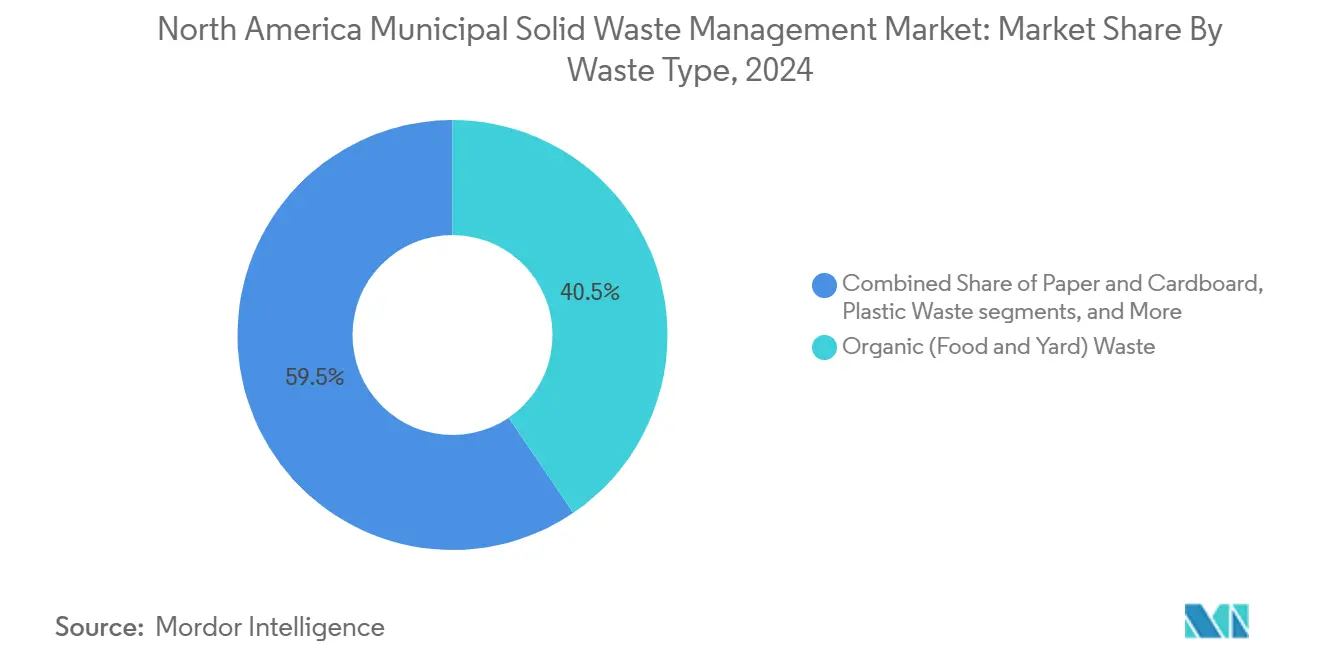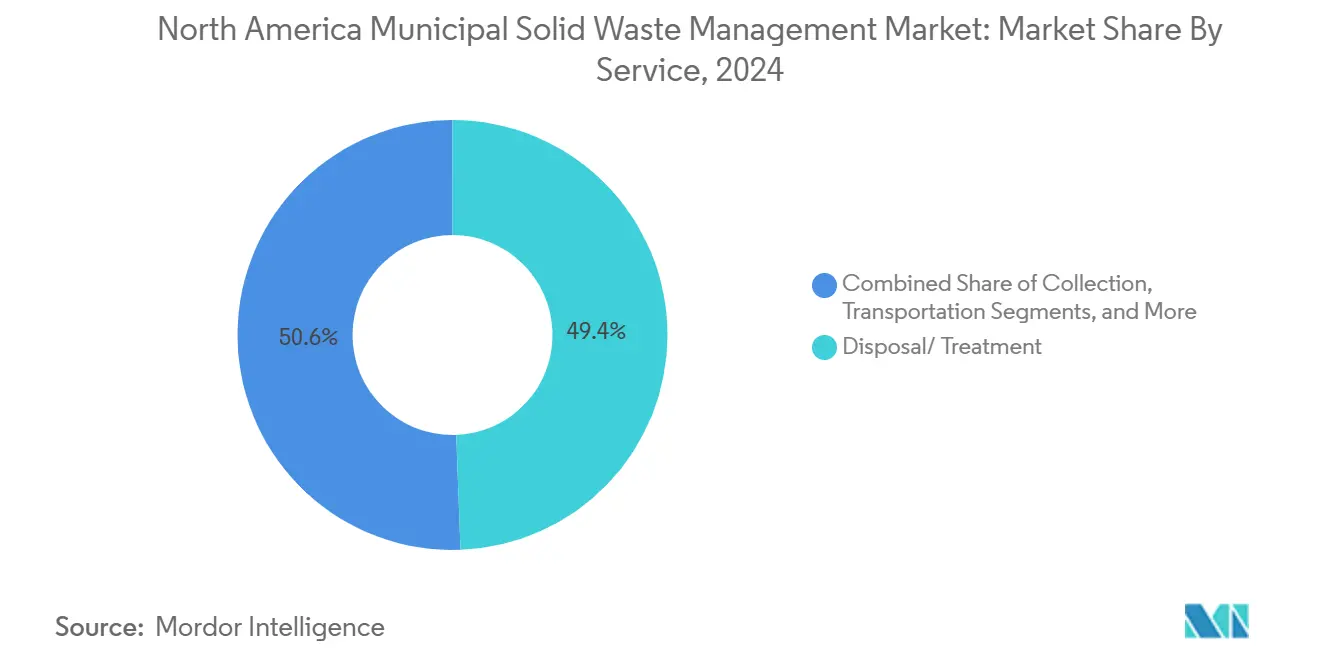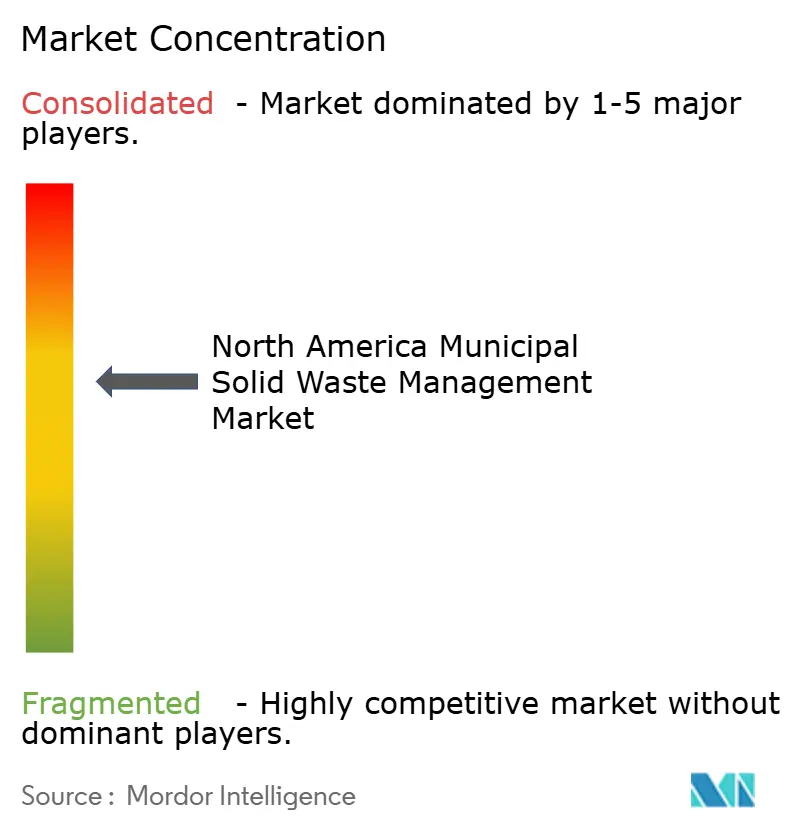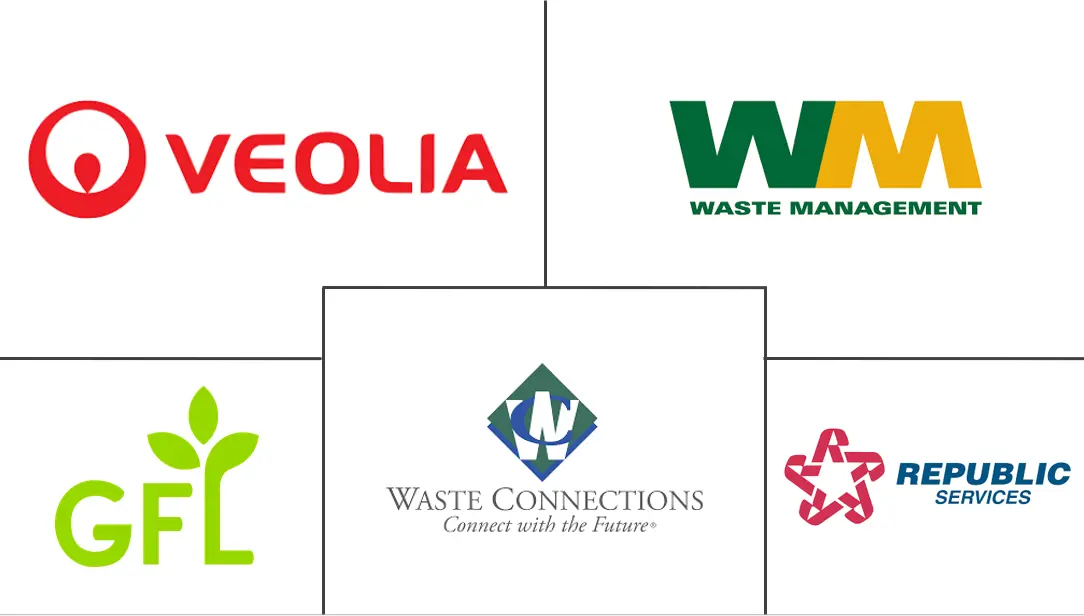North America Municipal Solid Waste Management Market Size and Share

North America Municipal Solid Waste Management Market Analysis by Mordor Intelligence
The North America Municipal Solid Waste Management Market size is estimated at USD 89.72 billion in 2025, and is expected to reach USD 121.49 billion by 2030, at a CAGR of 6.25% during the forecast period (2025-2030).
Current growth reflects a decisive shift from disposal-first practices toward integrated circular-economy models that reward material recovery, renewable energy generation, and producer-funded collection programs. Extended Producer Responsibility (EPR) legislation in five U.S. states and every Canadian province is accelerating this transition by transferring packaging disposal costs from municipalities to producers and, in turn, reshaping competitive economics. Higher landfill tipping fees, averaging USD 57.63 per ton in 2024, strengthen the business case for recycling and waste-to-energy (WtE) facilities, while corporate zero-landfill pledges generate premium demand for end-to-end diversion services[1]Environmental Research and Education Foundation, “2024 Landfill Tipping Fee Report,” Environmental Research and Education Foundation, erefdn.org.
Key Report Takeaways
- By waste type, organic waste led with 40.5% of the North America municipal solid waste management market share in 2024, whereas e-waste is projected to register the fastest 6.7% CAGR through 2030.
- By source, residential streams contributed 48.6% revenue share in 2024; commercial sources are expected to expand at a 5.8% CAGR to 2030.
- By service, the disposal and treatment category commanded 49.4% of the North America municipal solid waste management market size in 2024, but recycling and material recovery solutions are advancing at an 8.4% CAGR.
- By geography, the United States accounted for 75.5% share of the North America municipal solid waste management market size in 2024, while Mexico is forecast to grow the fastest at 7.7% CAGR.
North America Municipal Solid Waste Management Market Trends and Insights
Drivers Impact Analysis
| Driver | (~) % Impact on CAGR Forecast | Geographic Relevance | Impact Timeline |
|---|---|---|---|
| Extended producer-responsibility mandates boosting separate collection | +1.2% | U.S. Northeast, California, Canadian provinces | Short term (≤ 2 years) |
| Rapid urbanization concentrating waste generation in mega-cities | +0.9% | Mexico primary, U.S. Sun Belt, Canadian Prairie Provinces | Long term (≥ 4 years) |
| Heightened public awareness on zero-waste & circular-economy policies | +0.8% | North America, strongest in California, Oregon, Ontario | Medium term (2-4 years) |
| Rising landfill tipping fees favoring recycling & WtE economics | +0.7% | Pacific Coast, Northeast U.S., Metro Vancouver | Short term (≤ 2 years) |
| Digital transformation of waste logistics via IoT & smart bins | +0.6% | Urban centers across U.S. and Canada, limited Mexico penetration | Medium term (2-4 years) |
| Corporate zero-landfill commitments driving outsourced MSW services | +0.5% | North America, concentrated in Fortune 500 regions | Medium term (2-4 years) |
| Source: Mordor Intelligence | |||
Extended Producer-Responsibility Mandates Boosting Separate Collection
Minnesota’s 2024 EPR law brought the number of U.S. packaging EPR states to five, all of which require producers to finance collection through Producer Responsibility Organizations such as Circular Action Alliance. Provincial programs in Alberta and Quebec mirror or exceed these rules, with British Columbia already recording a 79.6% recovery rate, creating a clear revenue pool for waste operators equipped with advanced material recovery facilities. Standardized performance targets and contamination penalties reward vertically integrated firms capable of supplying uniform service across multi-state footprints[2]Environment and Climate Change Canada, “Extended Producer Responsibility Policies in Canada,” Environment and Climate Change Canada, canada.ca.
Rapid Urbanization Concentrating Waste Generation in Mega-Cities
Urban populations exceed 80% in both the United States and Canada, and Mexico’s metropolitan build-out drives similar density, generating concentrated organic streams that justify anaerobic digestion and biogas capture projects. High volumes improve economies of scale for recycling centers and WtE plants, but shrinking landfill buffers near big cities raise disposal costs, reinforcing market expansion in material recovery.
Heightened Public Awareness on Zero-Waste & Circular-Economy Policies
Public campaigns alongside city-level food-waste bans have elevated diversion targets to headline metrics in municipal procurement. Cox Enterprises, for example, achieved 92% landfill diversion—almost triple the continental average—after independent GreenCircle verification, illustrating how corporate leadership stimulates demand for advanced tracking and reporting solutions that prove environmental results. Municipalities now embed diversion performance clauses in bid documents, and Mexico City’s 2024 Zero Food Waste Certification obliges large generators to file semi-annual results, broadening the awareness-policy link beyond the United States. This rising scrutiny compels waste firms to invest in data platforms that document pound-for-pound outcomes.
Digital Transformation of Waste Logistics via IoT & Smart Bins
Waste Management’s Smart Truck platform links on-board computing, cameras, and mobile apps for route optimization and real-time service verification, cutting fuel use and elevating customer transparency. Beyond the curb, AI-enabled sortation—exemplified by AMP Robotics and Waste Connections’ forthcoming 62,000-ton Colorado facility—improves bale quality and reduces labor intensity. Digital differentiation thus enables premium pricing in data-hungry urban contracts, though rural markets lag due to smaller waste volumes.
Restraints Impact Analysis
| Restraint | (~) % Impact on CAGR Forecast | Geographic Relevance | Impact Timeline |
|---|---|---|---|
| High capital costs of advanced WtE & MRF infrastructure | -0.9% | North America, affecting smaller municipalities and rural areas | Long term (≥ 4 years) |
| Labour shortages & rising wage costs in collection operations | -0.8% | North America, most acute in urban markets | Short term (≤ 2 years) |
| Fragmented municipal procurement hindering economies of scale | -0.6% | U.S. and Canada, varies by state/province | Medium term (2-4 years) |
| Public opposition (NIMBY) to new landfills & incinerators | -0.4% | Suburban and rural communities | Short term (≤ 2 years) |
| Source: Mordor Intelligence | |||
High Capital Costs of Advanced WtE & MRF Infrastructure
ExxonMobil’s USD 200 million plastics-to-plastics expansion and Waste Management’s USD 3 billion five-year sustainability budget illustrate the massive outlays required to build next-generation recycling hubs and RNG plants. Such intensity secures competitive moats for capital-rich incumbents while sidelining smaller entrants and many municipalities, which increasingly rely on public-private partnerships to finance upgrades.
Fragmented Municipal Procurement Hindering Economies of Scale
Roughly 78% of U.S. jurisdictions outsource waste collection, yet contract terms vary widely, hampering route standardization and tech rollouts. EPA best-practice guidance suggests a 2-5-year lead time for tendering, a window most resource-constrained cities miss, undermining efficient fleet allocation and pushing up service costs. The North America municipal solid waste management market therefore operates below optimal density economics in many metro areas.
Segment Analysis
By Waste Type: E-Waste Catalyzes Technology Upgrades
E-waste captured the fastest forecast CAGR at 6.7%, yet organic waste held the largest 40.5% share of the North America municipal solid waste management market in 2024. North America generates 91 million tons of electronic scrap annually, but average recovery barely tops 15% in the United States, leaving substantial upside for dedicated processors. California’s Electronic Waste Recycling Act and recent provincial rules in Ontario are channeling manufacturer fees toward licensed recyclers, encouraging facilities equipped with robotic dismantlers and precious-metal recovery units[3]Z. Wen, “Barriers to Closed-Loop Glass Recycling,” npj Materials Sustainability, nature.com. Parallel advances in chemical recycling target plastic fractions within e-scrap, aligning with ExxonMobil’s scale-up of plastics-to-plastics processes. The segment’s regulatory clarity and commodity metal values entice integrated waste firms to build specialty lines alongside traditional MRFs, reshaping product portfolios as devices shrink in weight but rise in unit volumes.
Organic waste streams remain a stalwart revenue pillar, supporting anaerobic digestion, RDF, and compost facilities that monetize carbon credits and renewable natural gas. Feedstock certainty from municipal food-waste bans in California, Metro Vancouver, and soon Quebec permits stable long-term offtake contracts. Even so, e-waste’s technology pull is now the trend bellwether, prompting firms to pilot AI-based optical sorters geared to PCB and lithium-battery extraction. As integrated operators hedge landfill exposure, specialized e-waste plants increasingly anchor regional value chains and defend margins against commodity price swings.

Note: Segment shares of all individual segments available upon report purchase
By Source: Commercial Activity Outpaces Household Growth
Residential generators provided 48.6% of the North America municipal solid waste management market share in 2024, but commercial accounts will post a 5.8% CAGR to 2030 as office, retail, and food-service densify around urban cores. Corporate zero-landfill covenants force higher service complexity, prompting waste companies to supply in-building sortation, smart compactors, and detailed ESG dashboards that justify premium contracts. The construction and demolition (C&D) niche benefits from city-level “Waste No More” ordinances like Denver’s 65% diversion rule, expanding specialized recovery yards for concrete, timber, and gypsum.
Institutional waste—spanning hospitals, universities, and military bases—remains steady but margin-rich due to regulated medical and hazardous fractions that must meet strict chain-of-custody standards. Municipal street sweeping and parks maintenance provide counter-cyclical stability, yet limited budgets temper growth. Overall, the rising service complexity within the commercial channel encourages integrated firms to cross-sell audits, training, and reverse-logistics solutions that embed them deeper into client supply chains.
By Service: Material Recovery Accelerates Beyond Disposal
Disposal and treatment still wielded 49.4% of the North America municipal solid waste management market size in 2024, yet material recovery services are advancing at an 8.4% CAGR, reflecting shifting profit pools from landfill tonnage toward commodity sales and renewable energy credits. Route optimization software such as Waste Management’s Smart Truck suite reduces empty miles and enables same-day fill-level responses, freeing capacity for higher-value recycling pick-ups. At the plant gate, AI-assisted optical sorters produce cleaner PET, HDPE, and aluminum bales that fetch premium tariffs under EPR quality guidelines.
Energy-recovery projects, including RNG from anaerobic digestion and landfill gas, are gaining momentum as Clean Air Act thresholds tighten methane capture mandates. WM’s USD 131 million RNG facility outside Philadelphia exemplifies the trend toward multi-path monetization: gate fees, gas sales, and federal tax credits. Composting also scales quickly where state food-waste bans bite; California’s 75% organic diversion target drives steady feedstock inflows. Ancillary consulting and smart-bin monitoring, therefore, convert once-commoditized hauling into end-to-end resource-management engagements that compound revenue streams.

Note: Segment shares of all individual segments available upon report purchase
Geography Analysis
The United States commanded 75.5% of the North American municipal solid waste management market in 2024, boosted by extensive infrastructure, mature financing channels, and rising EPR adoption in states such as Maine, California, and Oregon. Coastal regions face the continent’s highest landfill tipping fee, USD 61.20 per ton on the Pacific Coast, supporting robust investment in recycling upgrades and WtE plants. In the Northeast, dense populations and limited disposal acreage foster economies of scale for vertically integrated operators that manage coast-to-coast logistics and consolidated bale marketing. The South enjoys lower land costs, yet population inflows spur gradual shifts toward WtE to buffer finite capacity, while the Mountain West commands premium contracts where long-haul disposal routes escalate transport expenses.
Canada, while smaller in absolute revenue, illustrates how EPR maturity can finance high diversion performance. British Columbia’s 79.6% recovery rate funds market-development grants that stimulate domestic reprocessing rather than export dependence. Alberta’s 2025 program replicates that roadmap, and Ontario’s metropolis cluster invests in smart-bin pilots to improve route density. Prairie cities such as Calgary weigh public-private partnerships to close the gap between abundant landfills and political appetite for circular initiatives, whereas Atlantic Canada leans on inter-municipal cooperation to justify capital-heavy facilities.
Mexico emerged as the fastest-growing geography at a 7.7% CAGR through 2030, propelled by rapid urbanization and federal frameworks under SEMARNAT that mandate municipal waste plans while enabling private concessionaires in large metros. Mexico City’s Zero Food Waste Certification compels large generators to document reduction and diversion, opening opportunities for regional waste companies employing bilingual digital dashboards. Northern border states leverage cross-border commodity channels for recovered plastics and metals, and tourist corridors in the Yucatán pursue integrated collection contracts to meet international sustainability benchmarks.
Competitive Landscape
Moderate market concentration typifies the North America municipal solid waste management market, with multibillion-dollar operators such as Waste Management, Republic Services, GFL Environmental, and Waste Connections capturing share through vertical integration. Their networks span residential hauling, transfer, MRF, landfill, WtE, and RNG assets, enabling cost stacking that regional independents struggle to match. Technology investment underscores strategy: Waste Management allocated USD 3 billion from 2022-2026 for 39 new or modernized recycling plants and 20 RNG units, while Republic Services runs seven RNG builds scheduled for 2025 commissioning.
M&A remains active. WM’s USD 7.2 billion Stericycle takeover in 2024 broadened healthcare waste capabilities and cross-sold existing customer bases, while GFL re-entered the acquisition arena with the 2025 purchase of OSI to deepen municipal contracts in the Midwest. Strategic bolt-ons fill geographic gaps and integrate specialty streams such as industrial wastewater and C&D debris, expanding share-of-wallet and route density. At the same time, digital innovators like AMP Robotics license AI sorters to incumbents, illustrating a cooperative tech ecosystem rather than wholly disruptive disintermediation.
Regional specialists maintain relevance by exploiting local knowledge, particularly in jurisdictions that favor community employment clauses or multilingual customer service. Family-owned haulers in California’s Central Valley, for instance, retain municipal loyalty on the promise of quicker in-person resolution and lower overhead. Nonetheless, rising capital thresholds for next-gen facilities and ESG reporting tilt bargaining power toward capital-rich national players, precipitating an ongoing roll-up of mid-tier operators.
North America Municipal Solid Waste Management Industry Leaders
Waste Management Inc.
Republic Services Inc.
Waste Connections Inc.
GFL Environmental Inc.
Veolia North America
- *Disclaimer: Major Players sorted in no particular order

Recent Industry Developments
- April 2025: WM opened four recycling and RNG facilities, adding 2.8 million tons of annual recycling capacity and 25 million MMBtu of RNG.
- April 2025: Republic Services closed USD 826 million in acquisitions, including Shamrock Environmental, and advanced seven RNG projects for a 2025 start-up.
- February 2025: GFL Environmental posted USD 6.1 billion solid-waste revenue for 2024 and targeted 30% greenhouse-gas reduction by 2030.
- January 2025: GFL Environmental Services acquired OSI to reinvigorate its North American expansion strategy.
Research Methodology Framework and Report Scope
Market Definitions and Key Coverage
Mordor Intelligence defines the North American municipal solid waste management (MSW) market as the organized collection, transfer, processing, material recovery, energy recovery, and final disposal of household-like wastes generated by residential, commercial, and institutional sources across the United States, Canada, and Mexico. Values are expressed in USD and capture service revenues as well as gate-fee income.
Scope exclusion: Construction and demolition debris, hazardous industrial residues, and liquid sludges fall outside this study's boundary.
Segmentation Overview
- By Waste Type
- Organic (Food & Yard) Waste
- Paper & Cardboard
- Plastic Waste
- Metal Waste
- Glass Waste
- E-Waste
- Textiles & Leather
- Others (Rubber, Wood, etc.)
- By Source
- Residential
- Commercial (Office, Retail, etc.)
- Institutional
- Municipal Services (Street Cleaning, Parks, etc.)
- Construction & Demolition
- By Service
- Collection, Transportation, Segregation & Pre-Processing
- Disposal / Treatment Method
- Recycling & Material Recovery
- Composting
- Anaerobic Digestion
- Energy Recovery (WtE / RDF / Biogas)
- Landfilling
- Others (Incineration without Energy Recovery, MBT)
- Ancillary and Support Services (Auditing, Consulting, Smart Waste Solutions, Etc.)
- By Geography
- United States
- Northeast US
- Midwest US
- South US
- West US
- Canada
- Atlantic Canada
- Central Canada (Ontario, Quebec)
- Prairie Provinces
- West Coast (British Columbia)
- Northern Territories
- Mexico
- North Mexico
- Central Mexico
- South & Yucatán Peninsula
- United States
Detailed Research Methodology and Data Validation
Primary Research
Structured interviews with public-works officers, private haulers, landfill operators, recycler associations, and WtE engineers across various states and Canadian provinces provided live price points, diversion targets, and capex plans that grounded key assumptions and clarified regulatory timelines.
Desk Research
Our analysts reviewed statutory data sets from the US EPA, Environment & Climate Change Canada, and Mexico's INEGI alongside trade releases from the Solid Waste Association of North America. We parsed company 10-Ks, landfill tariff filings, municipal bid documents, and news feeds in Dow Jones Factiva. D&B Hoovers supplied operator financials, while Questel patent alerts helped track technology uptake in optical sorting and anaerobic digestion. These examples illustrate, but do not exhaust, the secondary sources consulted.
Market-Sizing & Forecasting
The top-down model begins with per-capita MSW generation, population, and waste composition ratios, then adjusts for recycling and WtE diversion to derive fee-eligible tons. Average collection and disposal fees, validated through contract disclosures, translate tons to revenue. Bottom-up revenue roll-ups from listed haulers and sampled transfer-station gate receipts serve as a reasonableness check before reconciliation. Drivers such as landfill tipping fees, EPR coverage, RNG plant capacity, urbanization rate, GDP per capita, and WtE utilization feed a multivariate regression that projects value through 2030. Gaps in sub-regional figures are bridged with population-weighted interpolation tested against operator disclosures.
Data Validation & Update Cycle
Outputs pass three tiers of review: automated variance flags, peer analyst cross-checks, and senior sign-off. We revisit models quarterly when regulatory or M&A events move fundamentals; otherwise, a full refresh is issued each year, and an analyst re-verifies figures just before delivery.
Why Our North America Municipal Solid Waste Management Baseline Commands Reliability
Published numbers differ because firms pick unequal scopes, disposal stages, or forecast horizons. Mordor Intelligence reports the entire MSW service chain and updates models annually, whereas others may freeze datasets for several years or omit recycling income.
Key gap drivers include narrower geographic cuts, exclusion of material-recovery fees, varying assumed average service prices, and slower refresh cadence.
Benchmark comparison
| Market Size | Anonymized source | Primary gap driver |
|---|---|---|
| USD 113.72 B (2025) | Mordor Intelligence | |
| USD 52.07 B (2025) | Global Consultancy A | Omits transportation revenues and uses 2019 pricing constants |
| USD 49.96 B (2025) | Trade Journal B | Covers only publicly funded collection, excludes private contracts |
| USD 20.00 B (2024) | Regional Consultancy C | Focuses on disposal equipment sales, not service revenues |
These comparisons show that when consistent scope, current tariffs, and verified diversion rates are applied, Mordor's baseline offers decision-makers a balanced view that can be traced to clear variables and repeated with confidence.
Key Questions Answered in the Report
What is the current value of the North America municipal solid waste management market?
The market stands at USD 89.72 billion in 2025 and is forecast to reach USD 121.49 billion by 2030, growing at a 6.25% CAGR.
Which waste type holds the largest share today?
Organic waste leads with 40.5% market share, owing to abundant food and yard debris streams and expanding compost and RNG facilities.
Why are landfill tipping fees significant to market growth?
Average fees rose to USD 57.63 per ton in 2024, making recycling and waste-to-energy economically competitive and increasing demand for material recovery services.
Which geography is the fastest growing within North America?
Mexico is expanding at a 7.7% CAGR through 2030, driven by rapid urbanization and new regulatory frameworks encouraging private waste management investment.
How are EPR laws reshaping the industry?
EPR shifts financial responsibility for packaging recovery from municipalities to producers, creating steady revenue for waste firms equipped with efficient sorting and recycling infrastructure.
What technologies are most impactful in waste logistics?
IoT-enabled smart bins, AI-powered optical sorters and route-optimization platforms cut operating costs and deliver granular performance data valued by municipal and corporate clients.



